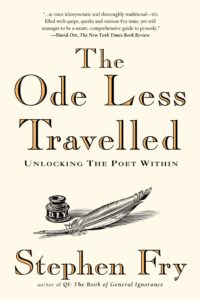Stephen Fry on Form, Part 5
 As I mentioned previously, I’m working through Stephen Fry’s The Ode Less Travelled very slowly to absorb as much wisdom as I can about writing poetry. This week’s post covers Chapter 3, Section 5, on the ode.
As I mentioned previously, I’m working through Stephen Fry’s The Ode Less Travelled very slowly to absorb as much wisdom as I can about writing poetry. This week’s post covers Chapter 3, Section 5, on the ode.
This section covers several different formats of odes, including Sapphic, Pindaric, Horatian, lyric, and anacreontic. The ongoing theme in this section is that the different types of odes may have their own metric structure, but they also are traditionally used for specific topics. For example, the anacreontic celebrates “pleasure, wine, erotic love, and the fleeting nature of existence.” In other words, eat, drink, and be merry, for tomorrow we may die.
Because these forms are largely taken from non-English languages and adapted into English, some of the rules of meter have been altered to work with the English language. Some of the examples Fry uses of Sapphic odes, for example, vary wildly in their line length. Some rhyme, while others don’t.
The Pindaric ode is an interesting form with three stanzas. In the first stanza, each rhymed couplet can be of a different length, but once you set that pattern in the first stanza, you’re stuck with it for the other two! It’s also meant to follow a structure of a strophe, stating the theme; an antistrophe, expressing doubt or another point of view; and an epode, uniting the two ideas or favoring one over the other. Or, put another way, a thesis, antithesis, and synthesis. I definitely want to give this form a shot at some point!
The Horatian and lyric odes are normally used to celebrate a person or thing (really, any noun may do) and were big favorites of the Romantic poets. And similarly to the Pindaric, they work in three parts, though here the parts usually describe, meditate on, and reach some insight regarding the subject. The Romantic poets were also fond of opening these odes with direct address of the subject being considered, giving them a vibe all their own.
Next up, closed forms!

Comments